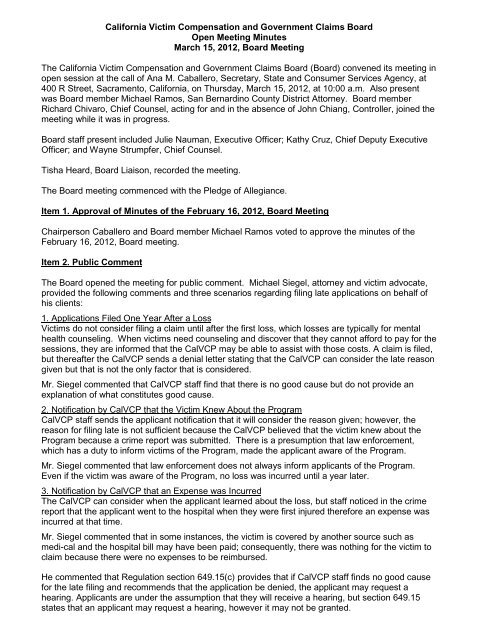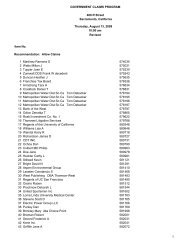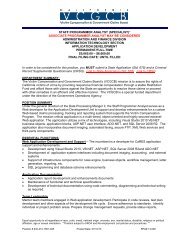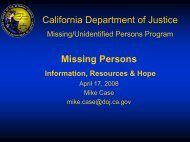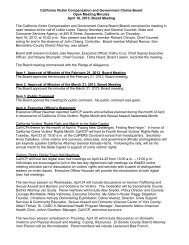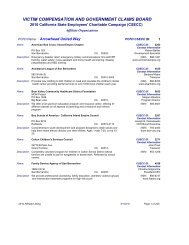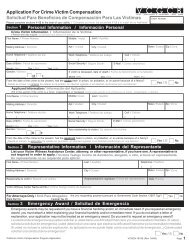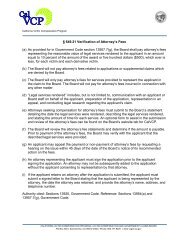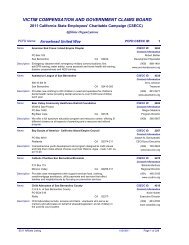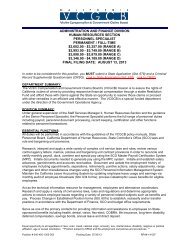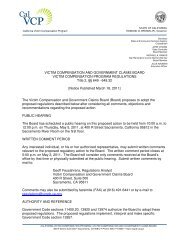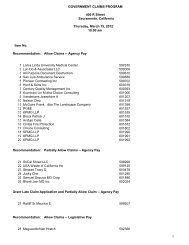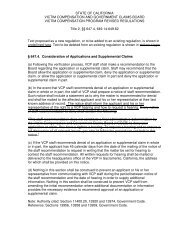Meeting Minutes - California Victim Compensation and Government ...
Meeting Minutes - California Victim Compensation and Government ...
Meeting Minutes - California Victim Compensation and Government ...
Create successful ePaper yourself
Turn your PDF publications into a flip-book with our unique Google optimized e-Paper software.
<strong>California</strong> <strong>Victim</strong> <strong>Compensation</strong> <strong>and</strong> <strong>Government</strong> Claims BoardOpen <strong>Meeting</strong> <strong>Minutes</strong>March 15, 2012, Board <strong>Meeting</strong>The <strong>California</strong> <strong>Victim</strong> <strong>Compensation</strong> <strong>and</strong> <strong>Government</strong> Claims Board (Board) convened its meeting inopen session at the call of Ana M. Caballero, Secretary, State <strong>and</strong> Consumer Services Agency, at400 R Street, Sacramento, <strong>California</strong>, on Thursday, March 15, 2012, at 10:00 a.m. Also presentwas Board member Michael Ramos, San Bernardino County District Attorney. Board memberRichard Chivaro, Chief Counsel, acting for <strong>and</strong> in the absence of John Chiang, Controller, joined themeeting while it was in progress.Board staff present included Julie Nauman, Executive Officer; Kathy Cruz, Chief Deputy ExecutiveOfficer; <strong>and</strong> Wayne Strumpfer, Chief Counsel.Tisha Heard, Board Liaison, recorded the meeting.The Board meeting commenced with the Pledge of Allegiance.Item 1. Approval of <strong>Minutes</strong> of the February 16, 2012, Board <strong>Meeting</strong>Chairperson Caballero <strong>and</strong> Board member Michael Ramos voted to approve the minutes of theFebruary 16, 2012, Board meeting.Item 2. Public CommentThe Board opened the meeting for public comment. Michael Siegel, attorney <strong>and</strong> victim advocate,provided the following comments <strong>and</strong> three scenarios regarding filing late applications on behalf ofhis clients:1. Applications Filed One Year After a Loss<strong>Victim</strong>s do not consider filing a claim until after the first loss, which losses are typically for mentalhealth counseling. When victims need counseling <strong>and</strong> discover that they cannot afford to pay for thesessions, they are informed that the CalVCP may be able to assist with those costs. A claim is filed,but thereafter the CalVCP sends a denial letter stating that the CalVCP can consider the late reasongiven but that is not the only factor that is considered.Mr. Siegel commented that CalVCP staff find that there is no good cause but do not provide anexplanation of what constitutes good cause.2. Notification by CalVCP that the <strong>Victim</strong> Knew About the ProgramCalVCP staff sends the applicant notification that it will consider the reason given; however, thereason for filing late is not sufficient because the CalVCP believed that the victim knew about theProgram because a crime report was submitted. There is a presumption that law enforcement,which has a duty to inform victims of the Program, made the applicant aware of the Program.Mr. Siegel commented that law enforcement does not always inform applicants of the Program.Even if the victim was aware of the Program, no loss was incurred until a year later.3. Notification by CalVCP that an Expense was IncurredThe CalVCP can consider when the applicant learned about the loss, but staff noticed in the crimereport that the applicant went to the hospital when they were first injured therefore an expense wasincurred at that time.Mr. Siegel commented that in some instances, the victim is covered by another source such asmedi-cal <strong>and</strong> the hospital bill may have been paid; consequently, there was nothing for the victim toclaim because there were no expenses to be reimbursed.He commented that Regulation section 649.15(c) provides that if CalVCP staff finds no good causefor the late filing <strong>and</strong> recommends that the application be denied, the applicant may request ahearing. Applicants are under the assumption that they will receive a hearing, but section 649.15states that an applicant may request a hearing, however it may not be granted.
<strong>Victim</strong> <strong>Compensation</strong> <strong>and</strong> <strong>Government</strong> Claims BoardOpen <strong>Meeting</strong> <strong>Minutes</strong>March 15, 2012Page 2 of 16Mr. Siegel commented that hearings are typically not granted <strong>and</strong>, in those instances, CalVCPsends a No Hearing Letter informing the applicant that although they appealed the denial, they failedto state a basis upon which relief may be granted. The applicant is given 30 days to submit writteninformation to refute the reason for denial or show that there is a basis upon which the Board maygrant relief. A response is submitted within the timeframe provided citing the law <strong>and</strong> the claim isplaced on the Board’s VCP agenda as a “Proposed Decision on the Written Record, ResponseReceived.” Subsequently, the Board adopts the proposed decision denying the claim. As a result, anumber claims are denied by the Board with no recourse.Item 3. Executive Officer’s Statement<strong>California</strong> Crime <strong>Victim</strong> Assistance Association (CCVAA) <strong>Victim</strong> <strong>Compensation</strong> CommitteeCCVAA, a professional association of county victim assistance centers, held its Committee meetingat headquarters on March 6 th . Heading the list of important topics regarding victim compensationincluded presentations by CalVCP on the state of the Restitution Fund, budget projections for JointPower (JP) contracts, the claim assignment process, legislation affecting the CalVCP, <strong>and</strong> upcomingevents in recognition of National Crime <strong>Victim</strong>s’ Rights Week in April.The Committee also discussed its upcoming conference cosponsored with the <strong>California</strong> DistrictAttorneys Association “Real Justice: <strong>Victim</strong>s’ Rights Delivered” that will be held on May 14-15 inSacramento. The focus of the conference will be underst<strong>and</strong>ing the needs <strong>and</strong> legal rights of crimevictims.Verification of Attorney’s Fees Automation Within CaRESToday began the implementation of the verification of attorney’s fees automation within CaRES, theCalVCP’s automated compensation <strong>and</strong> restitution tracking system. Over the past nine months,CalVCP’s Information Technology Section staff worked to program <strong>and</strong> implement additionalfunctionality within CaRES to support the verification of attorney’s fees that became effectiveNovember 7, 2011. The regulation implements the attorney fee statute by providing for verification ofattorney’s fees through fee statements documenting that attorney services were actually rendered tothe applicant. Due to the complex nature of processing documents <strong>and</strong> bills within CaRES, it hasbeen a collaborative effort with all CaRES stakeholders.<strong>California</strong> Crime <strong>Victim</strong>s’ Rights MonthCalVCP will participate in <strong>California</strong> Crime <strong>Victim</strong>s’ Rights Month. CalVCP will coordinate itsobservance with the National Crime <strong>Victim</strong>s’ Rights Week that will be observed April 22-28. Thisyear’s national theme is “Extending the Vision: Reaching Every <strong>Victim</strong>.” CalVCP will once againhost its <strong>Victim</strong>s’ Rights Rally at headquarters on April 24 th followed by a march to the Capitol toparticipate in other victims’ rights events <strong>and</strong> observances.Item 4. Contract ReportEvolve TechnologyTwo network switches for the CaRES modification infrastructure are needed to ensure security <strong>and</strong>improve the performance of the network. The purchase order in the amount of $52,612.69 includesthe purchase, installation, <strong>and</strong> three-year maintenance agreement.
<strong>Victim</strong> <strong>Compensation</strong> <strong>and</strong> <strong>Government</strong> Claims BoardOpen <strong>Meeting</strong> <strong>Minutes</strong>March 15, 2012Page 3 of 16Joint Powers (JP) ContractsThe Board has historically entered into JP agreements with various counties within the State toprovide fully verified victims of crime claims to the Board as required by <strong>Government</strong> Codesections 13954, 13962, <strong>and</strong> 13963. The 20 JP contracts in the amount of $11,062,834.00 reflect a 5percent reduction that became effective FY 2011-12. The one-year contracts for each county are thesame as the previous year.The Board voted to approve the JP contracts.Criminal Restitution Compact (CRC) ContractsThe Board works with the various counties’ criminal justice systems to ensure restitution fines <strong>and</strong>orders are properly administered in accordance with applicable statutes <strong>and</strong> to promote theappropriate assessment <strong>and</strong> collection of restitution fines, parole restitution fines, restitution orders,<strong>and</strong> diversion restitution fees. The 25 CRC contracts in the amount of $2,944,916.00 reflect a 5percent reduction that became effective FY 2011-12. The one-year contracts for each county arethe same as the previous year.The Board voted to approve the CRC contracts.Item 5. Legislative UpdateJon Myers, Deputy Executive Officer, Legislation <strong>and</strong> Public Affairs Division, reported the following:AB 1531 (Fuentes) ― <strong>Government</strong> Claims BillThe VCGCB's first <strong>Government</strong> Claims Bill of 2012 will cover claims approved by the Boardfrom June 2011 through December 2011.SB 1299 (Wright) ― <strong>Victim</strong>s of Crime: <strong>Compensation</strong>The bill makes numerous changes to eligibility requirements, benefit levels, <strong>and</strong> processingm<strong>and</strong>ates for CalVCP.SB 1479 (Pavley) ― Crime <strong>Victim</strong>s: RestitutionThe bill increases the minimum amount for restitution fines on felony convictions, which iscurrently set at $240 with scheduled increases to $280 in 2013 <strong>and</strong> $300 in 2014. This billinstead increases the minimum to $350 in 2013 <strong>and</strong> $400 in 2014. It also increases themaximum restitution fine from $10,000 to $15,000 in 2013. The author’s office stated that thebill was intended to be a spot bill. The author will amend it to address restitution for therecording industry in cases of piracy <strong>and</strong> does not intend to address minimum restitutionfines or victims of violent crime.SB 1210 (Lieu) ― Restitution: Collection of FinesThe bill addresses two areas of concern with restitution collection after the implementation ofpublic safety realignment, which moves certain classifications of offenders from CDCR tolocal jurisdictions. The bill gives counties the authority to collect up to 50 percent of thewages <strong>and</strong> trust account deposits of prisoners in county jails <strong>and</strong> assesses a 10 percentadministrative fee. It also requires an individual who violates post-release communitysupervision or m<strong>and</strong>atory supervision <strong>and</strong> is rem<strong>and</strong>ed back to jail to pay a revocation fine,as is currently assessed against individuals who violate parole <strong>and</strong> are rem<strong>and</strong>ed back toprison.AB 1945 (Morrell) ― Restitution: County JailsSimilar to SB 1210, AB 1945 gives counties the authority to collect up to 50 percent of thewages <strong>and</strong> trust account deposits of prisoners in county jails <strong>and</strong> assesses a 10 percentadministrative fee.SB 1371 (Anderson) ― <strong>Victim</strong> Restitution: Private Debt CollectorThe bill allows the VCGCB, with the victims' consent, to contract with a private debt collectorfor direct restitution orders.
<strong>Victim</strong> <strong>Compensation</strong> <strong>and</strong> <strong>Government</strong> Claims BoardOpen <strong>Meeting</strong> <strong>Minutes</strong>March 15, 2012Page 4 of 16AB 1157 (Nielsen) ― Public Entity Liability: Payment of ClaimsThe bill restores a provision that was briefly implemented <strong>and</strong> later repealed in 2011 throughbudget trailer bill language. The provision requires the VCGCB to notify the Legislature priorto allowing a government claim of $500,000 or more to be paid from a current yearappropriation for prior year costs. It also applies to multiple claims totaling $500,000 or morein one year by a single vendor against a single department.Chairperson Caballero commented that she was concerned about the possibility of inmates being inviolation of their probation if the money taken out of their trust account is used to pay restitutionrather than their obligation to pay child support. She requested more information regardingAB 1945, the bill that gives counties the authority to collect up to 50 percent of the wages <strong>and</strong> trustaccount deposits of prisoners in county jails <strong>and</strong> assesses a 10 percent administrative fee.Item 6. <strong>Government</strong> Claims ProgramConsent Agenda (Nos. 1- 260)The Board adopted the staff recommendations for item numbers 1-260, with the followingexceptions: items numbers 73 (598547), 81 (599775), 85 (600217), 253 (597056), <strong>and</strong> 256(601692) were removed to allow the claimants an opportunity to address the Board <strong>and</strong> item number172 (601981) was removed pending review of additional information received.Consent Agenda AppearanceItem 85, G600217Claim of Naresh BalaniNaresh Balani participated in the meeting via conference call. Prior to the Board meeting, Mr. Balanisubmitted written information for Board consideration in support of his claim. Reese Griffith, GriffithCompany, appeared on behalf of Mr. Balani. Peter Ackeret, attorney, appeared on behalf of the<strong>California</strong> Department of Transportation.Jackie Tinetti explained that Naresh Balani requested compensation in the amount of $30,486.00from the <strong>California</strong> Department of Transportation for loss of business <strong>and</strong> merch<strong>and</strong>ise. TheDepartment of Transportation recommended that the claim be rejected. The <strong>Government</strong> ClaimsProgram staff recommended that the claim be rejected because the issues involved were complex<strong>and</strong> outside the scope of analysis typically undertaken by the Board.Mr. Ackeret explained that in May 2011, a contractor performing repair on a highway closed a restarea due to a safety issue. The Department of Transportation (Caltrans) did not receive prior noticeof the closure until the day before the rest area was due to close. Caltrans became aware of Mr.Balani’s concern after they began receiving telephone calls <strong>and</strong> emails from an assembly member.Upon finding out that the rest area was going to be closed, Caltrans sent Mr. Balani an emailnotifying him of the closure; unfortunately, it was the night before the closure. Caltrans provided Mr.Balani with the telephone number of an individual to contact if he needed special arrangements toreceive his product.He stated that Mr. Balani was seeking lost product <strong>and</strong> lost future earnings. Caltrans believed theamount sought <strong>and</strong> the claim itself involved complex issues of law <strong>and</strong> fact. Based on theinformation regarding the claim <strong>and</strong> the documents Caltrans had in their possession, they could notdetermine whether Mr. Balani had a contract, who the contract was with, whether the contractexpired, the terms of the contract, whether the contract had specific provisions as to damages suchas the damages claimed, or whether there was a damage cap. In absence of all of those unknownanswers, as well as Mr. Balani’s calculation as to the damages which would typically require a trial
<strong>Victim</strong> <strong>Compensation</strong> <strong>and</strong> <strong>Government</strong> Claims BoardOpen <strong>Meeting</strong> <strong>Minutes</strong>March 15, 2012Page 5 of 16or an economist to forecast future losses, Mr. Ackeret stated that Caltrans recommended that theBoard reject the claim so that the matter could be pursued in the appropriate forum.Mr. Balani explained that he is a blind licensed vendor with the State of <strong>California</strong> with theDepartment of Rehabilitation. Under the R<strong>and</strong>olph-Sheppard Act of 1936, priority is given to blindpersons to operate vending facilities on federal property. He was appointed a vendor in February2000 <strong>and</strong> operated the br<strong>and</strong> new facility site. When the location was closed down, he was givenless than eight hours’ notice. He was subsequently told that the closure was not due to a safetyissue rather the contractor was only performing road maintenance. The construction was supposedto last two months but it took six months for the construction to conclude. A contract was signedprior to the construction so the closure was not due to a safety issue as Caltrans stated. Further, allof the income that he earned from the prior year is documented with a profit <strong>and</strong> loss statement <strong>and</strong>the Department of Rehabilitation could verify his income.Chairperson Caballero asked Mr. Balani with whom he had a contract.Mr. Balani stated that he had a contract with the Department of Rehabilitation which had a contractwith Caltrans, which is how the Business Enterprises Program worked. He stated that he wasclaiming loss of inventory as a result of the closure. He contacted the Griffith Company, Caltrans’contractor, <strong>and</strong> was told that it was Caltrans’ responsibility to notify him of the closure.Reese Griffith stated that he is a vendor who worked with Caltrans. He explained that typically anagency has an agreement with the Department of Rehabilitation <strong>and</strong> the Business EnterprisesProgram for the blind selects a vendor <strong>and</strong> they have an agreement. According to Naresh, he didnot receive proper notice of the closure; therefore, he had to dispose of his supplies. Theconstruction was supposed to last one to two months, but it lasted six months. He stated that hecarries a products liability insurance that protects the department <strong>and</strong> consumers, but it is h<strong>and</strong>ledby the Department of General Services. He commented that Mr. Balani has a young family <strong>and</strong> wasa good vendor <strong>and</strong> hard worker. He stated that he thought that the Department of Rehabilitationnormally dealt with Naresh, but the present manager of the Department of Rehabilitation, DebMyers, took the position that the Department of Rehabilitation does not go against its sisteragencies, which is the reason that the Department of Rehabilitation was not in attendance at themeeting. He commented further that the Department of Rehabilitation is supposed to look out for itsclients interests.Chairperson Caballero stated that she appreciated Mr. Griffith’s participation in the meeting;however, without input from the Department of Rehabilitation, the Board was missing importantinformation. Further, Mr. Balani’s claim is the type of claim that the Board does not generallyconsider because it requires a court of law to go through disputed facts.Jackie Tinetti, Manager, <strong>Government</strong> Claims Program, stated that Deb Myers of the Department ofRehabilitation was contacted <strong>and</strong> the claim was discussed with her at length, but internaldiscussions at the Department of Rehabilitation resulted in the decision not attend the meeting. TheDepartment of Rehabilitation is not a party to the claim therefore they did not attend.Chairperson Caballero stated that it was unfortunate that a representative from the Department ofRehabilitation decided not to attend; they should have attended <strong>and</strong> given advice. She stated thatthe Board’s only alternative was to reject the claim because the Board was not in a position to makea finding of fact in the case. She further stated that she was uncomfortable making the decision toreject the claim; however, there was no other choice.
<strong>Victim</strong> <strong>Compensation</strong> <strong>and</strong> <strong>Government</strong> Claims BoardOpen <strong>Meeting</strong> <strong>Minutes</strong>March 15, 2012Page 6 of 16Board member Ramos stated that he agreed with Chairperson Caballero’s apprehension to rejectthe claim, but the Board had no other option. He moved the staff recommendation to reject theclaim.Chairperson Caballero apologized for the outcome, but the Board had no other option because theBoard does not have the ability to conduct the fact finding that is required. She explained that Mr.Balani now had the opportunity to pursue the matter in court. Chairperson Caballero also thankedMr. Griffith for taking the time to appear at the meeting.The Board voted to adopt the staff recommendation to reject the claim.After voting on the item, Board member Ramos excused himself from the meeting.Consent Agenda AppearanceItem 73, G598547Claim of Daniel J. StadtlerDaniel J. Stadtler appeared <strong>and</strong> addressed the Board. In lieu of the <strong>California</strong> Department of Food<strong>and</strong> Agriculture’s appearance, Greg Lawley, Chief, Bureau of Livestock Identification, submitted awritten communication to the Board that included a recommendation to reject the claim.Jackie Tinetti, Manager, <strong>Government</strong> Claims Program, explained that Daniel J. Stadtler requestedcompensation from the <strong>California</strong> Department of Food <strong>and</strong> Agriculture in the amount of $1,484.51which represented the difference between the amount he stated he paid for his cattle <strong>and</strong> theamount he received after the cattle were sold at auction without his permission.Ms. Tinetti stated that based on the facts of the claim <strong>and</strong> the recommendation provided by the<strong>California</strong> Department of Food <strong>and</strong> Agriculture, the <strong>Government</strong> Claims Program staff recommendedthat the Board reject the claim.Mr. Stadtler stated that he had a br<strong>and</strong> on the cattle that were sold <strong>and</strong> he had receipts tosubstantiate the purchase of the cattle. He alleged negligence on the part of the Department of Food<strong>and</strong> Agriculture because the br<strong>and</strong> inspector should have known that he was the only one who hadMexican cattle. He stated that he saw five steers <strong>and</strong> four had his tag. The inspector looked at them<strong>and</strong> one had the br<strong>and</strong> but the others had hair that had grown over the br<strong>and</strong>. The cattle weresubsequently shipped to the Escalon Livestock Market <strong>and</strong> sold. The cattle were required to be held30 days before being sold so that a br<strong>and</strong> inspector could inspect the steer for br<strong>and</strong>s. The cattlewere not clipped to see if there were any br<strong>and</strong>s until the day of the sale. On the day of the sale,three cattle were clipped on the right side however his br<strong>and</strong> was on the left side <strong>and</strong> none of thesteers were clipped on that side.Chairperson Caballero explained that there was no dispute that the cattle belonged to Mr. Stadtler.The issue before the Board was the difference between the purchase price <strong>and</strong> the price that theywere sold. She asked Mr. Stadtler if he had a receipt for the amount that he paid for the cattle.Mr. Stadtler stated that he did <strong>and</strong> produced two receipts <strong>and</strong> an invoice.Chairperson Caballero stated that now the issue before the Board was not whether Mr. Stadtlershould be paid; rather, it was the amount that he should be reimbursed. Chairperson Caballerorequested <strong>Government</strong> Claims Program staff review the receipt submitted by Mr. Stadtler. Shestated that the Board would put the claim over to allow Mr. Stadtler an opportunity to meet with staffto try to resolve his claim.
<strong>Victim</strong> <strong>Compensation</strong> <strong>and</strong> <strong>Government</strong> Claims BoardOpen <strong>Meeting</strong> <strong>Minutes</strong>March 15, 2012Page 7 of 16Executive Officer Nauman stated that staff would review the receipts <strong>and</strong> contact the <strong>California</strong>Department of Food <strong>and</strong> Agriculture to make them aware of the new information submitted.Ms. Tinetti stated that staff would compare the existing information in the file to the new informationsubmitted <strong>and</strong> share the information with the Department of Food <strong>and</strong> Agriculture.Consent Agenda AppearanceItem 81, G599775Claim of Allain D. BarfieldAllain Barfield appeared <strong>and</strong> addressed the Board. John McDonough, Senior Supervisor Counsel,appeared on behalf of the <strong>California</strong> Highway Patrol.Jackie Tinetti, Manager, <strong>Government</strong> Claims Program, explained that Allain Barfield requestedreimbursement from the <strong>California</strong> Highway Patrol in the amount of $2,100.00 for vehicle impoundfees. She stated that the Board previously rejected Mr. Barfield’s claim at its meeting onJanuary 19, 2012. Mr. Barfield was scheduled to address the Board at that time, but he did notappear due to a misunderst<strong>and</strong>ing regarding the meeting.Chief Counsel Wayne Strumpfer stated that in order to reconsider the claim, the Board member whomade the motion to reject the claim would need to make a motion to rehear the claim. Mr. Strumpferstated that Board member Chivaro made the motion to reject the claim; therefore, he would need tomake a motion to reconsider it.Board member Chivaro made a motion to reconsider the claim <strong>and</strong> Chairperson Caballero secondedthe motion.Mr. Stadtler stated that while he was driving his new car that had dealer places <strong>and</strong> a stickerdisplayed in the window, a CHP officer pulled him over for no apparent reason. He stated that theofficer had something against him, which was the reason that the officer pulled him over. The CHPofficer was two cars behind him <strong>and</strong> could not tell that he had dealer plates. He stated that he madea left had turn <strong>and</strong> the CHP followed him <strong>and</strong> pulled him over. The officer asked him who the carbelong to <strong>and</strong> asked for his identification. He told the officer that the car belonged to him <strong>and</strong> hegave the officer his identification. After checking his information, the officer informed Mr. Barfieldthat he had outst<strong>and</strong>ing tickets. He stated that he told the officer that the tickets were dismissed.The officer told Mr. Barfield that according to information in his computer, the tickets remainedunpaid.Chairperson Caballero asked Mr. Barfield if he took care of the outst<strong>and</strong>ing tickets before theincident occurred.Mr. Barfield stated that he had a DUI in 1992 <strong>and</strong> a house fire in September 2010 <strong>and</strong> did not knowthat his license was suspended until after the house fire. He stated that he went to DMV when hefound out that the DUI was still on his record. He took a class required by DMV <strong>and</strong> completed it inMarch. He was supposed to receive a certificate of completion, which he has not yet received, buthis driving record with DMV is all cleared up.Chairperson Caballero asked Mr. McDonough to clarify whether the impoundment occurred inAugust <strong>and</strong> if Mr. Barfield took the class in March.John McDonough stated that at the time of the stop by the CHP officer in August, Mr. Barfield’s cardid not display front plates, license tags, <strong>and</strong> it was determined that he was driving on a suspendedlicense for a failure to appear. It was possible that he cleared his records with DMV in March, but it
<strong>Victim</strong> <strong>Compensation</strong> <strong>and</strong> <strong>Government</strong> Claims BoardOpen <strong>Meeting</strong> <strong>Minutes</strong>March 15, 2012Page 8 of 16appeared as a suspended a license in the officer’s computer therefore the vehicle was impoundedfor 30 days. Mr. Barfield could have requested an impound hearing but he did not. He cleared upthe matter with DMV before the trial which was the reason that the judge ruled in his favor.Mr. Barfield stated that the stop by the officer was unwarranted. The car had new dealer stickerswhich is what he was supposed to have on a new car <strong>and</strong> which was the reason that the judge ruledin his favor.Chairperson Caballero stated that the Board was not to determine whether the CHP officer hadreason to stop Mr. Barfield. The Board would determine whether the CHP officer was acting withinthe law <strong>and</strong> policy. The fact that Mr. Barfield had a suspended license, according to the DMV,meant that he could not drive until it was cleared up. The challenge for the Board was whether theofficer followed the law, which it is clear that he did.Mr. Barfield asked the Board if they had an opportunity to read the CHP report that noted that he didnot see anything displayed on the vehicle, which the CHP alleged was the reason for the stop. Theofficer could not see the front or back of his car because a car was in between his vehicle <strong>and</strong> theCHP officer. Mr. Barfield stated that he was in a Hispanic area at the time, which was tragicallywhere young children were killed by a young black male. He stated that when the officer lookedthrough the window of his car, he only wanted to see who he was <strong>and</strong> find out what he was doing inthat area of town. He told the officer that he had a friend who lived in the area.Chairperson Caballero <strong>and</strong> Board member Chivaro voted to reject the claim. Chairperson Caballeroexplained that the Board’s decision to reject the claim had nothing to do with the stop or the cause ofthe stop. The Board’s role was to determine if there was sufficient information that the CHP used toimpound the vehicle. She also stated that there was a process that Mr. Barfield could have followedto try to get his car out of impound but he chose not to pursue it.Consent Agenda AppearanceItem 253, G597056Claim of Cathleen GlazzyCathleen Glazzy appeared. Lisa Roberts appeared <strong>and</strong> addressed the Board on behalf ofMs. Glazzy. John McDonough, Senior Supervising Counsel, appeared on behalf of the <strong>California</strong>Highway Patrol.Jackie Tinetti, Manager, <strong>Government</strong> Claims Program, explained that Cathleen Glazzy requestedreimbursement from the <strong>California</strong> Highway Patrol in an unspecified amount for personal injury <strong>and</strong>medical bills as a result of a vehicle accident. <strong>Government</strong> Claims Program staff determined that theclaim was not timely pursuant to <strong>Government</strong> Code sections 910 <strong>and</strong> 911.2. Ms. Glazzysubsequently submitted an application for leave to present a late claim. The Attorney General’sOffice reviewed the facts <strong>and</strong> recommended that the late application be denied for failure to meetthe criteria required in <strong>Government</strong> Code section 911.6. Based on the review of the facts <strong>and</strong> therecommendation of the Attorney General’s Office, <strong>Government</strong> Claims Program staff recommendedthat the late application be denied pursuant to <strong>Government</strong> Code section 911.6.Mr. McDonough stated that the <strong>California</strong> Highway Patrol concurred with the <strong>Government</strong> ClaimsProgram staff recommendation to deny the claim as untimely.Ms. Roberts stated that the staff recommendation to deny the late application is based upon<strong>Government</strong> Code section 911.6 which clearly provides that the Board could set aside the denial ofthe late claim if there is a mistake, inadvertence, surprise or excusable neglect, which applies to
<strong>Victim</strong> <strong>Compensation</strong> <strong>and</strong> <strong>Government</strong> Claims BoardOpen <strong>Meeting</strong> <strong>Minutes</strong>March 15, 2012Page 9 of 16Ms. Glazzy. She stated that Ms. Glazzy mailed her claim timely on April 28, 2011, approximately 4-5 days before the 6-month expiration. The claim was unfortunately returned due to insufficientpostage <strong>and</strong> came back to her home on May 4, 2011. She mailed the claim back with appropriatepostage <strong>and</strong> it was received by the <strong>Government</strong> Claims Program a few days later. She stated thatthe claim involved Ms. Glazzy who, through her insurance company, submitted the property damageclaim. The State was fully aware of the claim based upon the submittal of the property damagethrough the insurance company <strong>and</strong> there is no prejudice to the State. It seemed appropriate thatMs. Glazzy should be allowed to proceed with her claim given that there was notice to the State inaddition to the fact that the mail mishap was insignificant in terms of time, because it was only amatter of a week or so late.Chairperson Caballero asked Ms. Roberts if Ms. Glazzy enclosed the returned envelope in anotherenvelope <strong>and</strong> re-mailed both envelopes to the <strong>Government</strong> Claims Program.Ms. Roberts stated that <strong>Government</strong> Claims Program would have received the envelope with astamp indicating insufficient postage plus the envelope with the additional postage.Chairperson Caballero asked Ms. Tinetti whether staff had any information regarding the doublemailing.Ms. Tinetti stated that staff always retains envelopes. If Ms. Glazzy mailed both envelopes, it wouldbe reflected in the file.Board member Chivaro asked Ms. Tinetti if staff looked at that information when making thedetermination regarding whether the claim was late.Ms. Tinetti stated that all information submitted is reviewed. Determining timeliness of a claim is alegal decision, which was the reason that the Attorney General’s Office <strong>and</strong> CalVCP Legal staff wereconsulted. Both reviews occurred <strong>and</strong> both concluded the same.Ms. Roberts stated that the question of whether the claim was late is not in dispute; however,<strong>Government</strong> Code section 911.6 should apply regarding failure to present the claim throughmistake, inadvertence, surprise or excusable neglect <strong>and</strong> the public entity was not prejudiced. Thepublic entity was clearly on notice <strong>and</strong> has accepted liability for the accident at issue; therefore, it isappropriate for the department to accept the balance of Ms. Glazzy’s personal injury claim.Chairperson Caballero stated that the challenge for the Board was that the Board did not have anyinformation regarding the details presented by Ms. Roberts on behalf of Ms. Glazzy. The Board onlyhad a conclusion <strong>and</strong> needed to determine whether the conclusion was adequate given that therewere instances where Ms. Roberts could make a finding that good cause existed.Executive Officer Nauman stated that staff had Ms. Glazzy’s claim file <strong>and</strong> could present it to theBoard for their review to determine if the envelope in question was contained in the file.Chairperson Caballero <strong>and</strong> Board member Chivaro, with assistance from Chief Counsel WayneStrumpfer, reviewed the claimant’s file <strong>and</strong> determined that the envelope stamped insufficientpostage was not contained in the file as previously asserted by Ms. Roberts.Chairperson Caballero stated that she listened carefully to the information provided by Ms. Robertsregarding the double mailing; however, the envelope in the file did not indicate that it was returnedor that it was re-mailed. The file contained an envelope that only had a stamp dated May 6, 2011,which was the date the stamp was purchased <strong>and</strong> a check dated April 29, 2011. The envelope didnot indicate that it was mailed twice. There was nothing in the file to indicate that the package was
<strong>Victim</strong> <strong>Compensation</strong> <strong>and</strong> <strong>Government</strong> Claims BoardOpen <strong>Meeting</strong> <strong>Minutes</strong>March 15, 2012Page 10 of 16returned <strong>and</strong> re-mailed. Given that information, the Board was convinced that was the reason staffmade the recommendation to deny the claim for a late filing.Chairperson Caballero <strong>and</strong> Board member Chivaro voted to adopt the staff recommendation to denythe late application.Consent Agenda AppearanceItem 256, G601692Claim of Louie ZaunerLouie Zauner appeared <strong>and</strong> addressed the Board. Vasilios Spyridakis, Staff Counsel, appeared <strong>and</strong>addressed the Board on behalf of the <strong>California</strong> Department of Veterans Affairs.Jackie Tinetti, Manager, <strong>Government</strong> Claims Program, explained that Mr. Zauner requestedcompensation in the amount of $7,500.00 for defamation allegedly caused by the <strong>California</strong>Department of Veterans Affairs on May 2, 2011. Mr. Zauner also submitted an application for leaveto present a late claim because he presented his claim more than six months beyond the accrual ofthe cause of action. <strong>Government</strong> Claims Program staff determined that the claim was not timelypursuant to <strong>Government</strong> Code sections 910 <strong>and</strong> 911.2. Further, based upon the facts of the claim<strong>and</strong> the <strong>California</strong> Department of Veterans Affairs recommendation to deny the late claimapplication, <strong>Government</strong> Claims Program staff recommended that the Board deny the lateapplication.Mr. Zauner stated that his claim involved defamation <strong>and</strong> a late filing. He explained that heappeared in small claims court with his attorney, but the judge who heard the case told him that hehad to file a government tort claim before he could hear his case. He <strong>and</strong> his attorney were told thathe had six months to file a claim. He immediately filed a government claim <strong>and</strong> provided a reasonfor the late claim filing; however, the claim was denied. Thereafter, he double-checked theinformation provided on the government claim form <strong>and</strong> believed that a claim for defamation couldbe filed within one year from the accrual of the cause of action. His attorney submitted a letterexplaining that the claim was not late. Subsequently, he was made aware that his claim was stillbeing denied because it was filed late.Chairperson Caballero asked Ms. Tinetti whether the filing period was six months after the accrual ofthe case of action. Ms. Tinetti stated that defamation is a form of personal injury under the law <strong>and</strong>therefore the claim must have been presented within six months.Mr. Zauner stated that immediately after the defamation incident with the <strong>California</strong> Department ofVeterans Affairs, his attorney filed a dem<strong>and</strong> with the department. The dem<strong>and</strong> was rejected so hisattorney advised him to file the claim as an individual in small claims court, which he did. After threehearings, the judge told him that he had to file a government tort claim. All of the time spent in courtcaused a delay in filing within the six-month filing period. He stated that after reading theinformation on the government claim form, he believed that he could file within one year because itdid not appear that defamation claims had to be filed within a six-month period.Mr. Spyridakis stated that the issue of Mr. Zauner’s claim involved timeliness. <strong>Government</strong> Codesection 911.2(a) differentiates between causes of action for death or for injury to person or topersonal property or growing crops, which shall be presented not later than six months after theaccrual of the cause of action, <strong>and</strong> claims relating to any other causes of action shall be presentednot later than one year after the accrual of the cause of action. He stated that Mr. Zauner’s claim ofdefamation falls under the six-month filing period. He explained that shortly after the alleged injurestook place in May 2001, Mr. Zauner sought an attorney. His attorney sent a dem<strong>and</strong> letter forcompensation to the Department of Veteran’s Affairs Legal Office <strong>and</strong> the dem<strong>and</strong> was rejected.
<strong>Victim</strong> <strong>Compensation</strong> <strong>and</strong> <strong>Government</strong> Claims BoardOpen <strong>Meeting</strong> <strong>Minutes</strong>March 15, 2012Page 11 of 16Later the relationship with Mr. Zauner <strong>and</strong> his attorney was terminated. Mr. Zauner submitted asevidence in his subsequent small claims action in Superior Court a letter sent back to him from hisattorney upon terminating the representation. The letter cautioned Mr. Zauner “please keep in mindthat the law imposes strict time limits within which you must act to protect your rights in this matter.You should act immediately if you wish to pursue this matter. Failure to comply with the statutorytime limits in a lawsuit could bar you from pursuing the matter.” Mr. Spyridakis stated that, based onthe advice letter from Mr. Zauner’s attorney, he was put on notice that there was an issue regardingthe statute of limitation <strong>and</strong> he should pursue legal remedies <strong>and</strong> advice. Subsequently Mr. Zaunerretained another attorney <strong>and</strong> served the <strong>California</strong> Department of Veterans Affairs with a civil claimfor defamation in small claims court, bypassing the government claims process. The <strong>California</strong>Department of Veterans Affairs responded with the defense of failure to file a government tort claim<strong>and</strong> the statute of limitations, putting him on notice a second time. He stated that Mr. Zauner’sattorney responded <strong>and</strong> both parties went to court. The judge raised the issue regarding thesix-month statute of limitations <strong>and</strong> suggested that Mr. Zauner pursue filing a government claim.Mr. Zauner elected not to pursue the government claims process <strong>and</strong> the hearing was continued.On December 9, the judge dismissed the action for failure to file the government tort claim. Further,Mr. Spyridakis stated that Mr. Zauner had been given adequate notice regarding the filing of hisclaim. He added that Mr. Zauner may have a legal remedy against his attorney for legalmalpractice.Mr. Zauner stated that his first attorney advised him in writing that he had a right to file a claim as anindividual against Marcella McCormack, Administrator, <strong>California</strong> Department of Veterans Affairs.He took his attorneys advice, which may have been a poor advice, <strong>and</strong> pursued the matter in smallclaims court. The evening before the 8:00 a.m. hearing, he received the first brief from the defendantoutlining all of the details that he did not comply. He stated that the judge recognized that he did nothave sufficient time to review the brief <strong>and</strong> postponed the trial to give him an opportunity to reviewthe documentation. Subsequently, he filed a brief in response <strong>and</strong> at the second hearing the judgeadvised him to file a government tort claim.Chairperson Caballero stated that Mr. Zauner’s attorney did not serve him well. A qualified <strong>and</strong>experienced attorney who would have ensured that Mr. Zauner satisfied all of the time limitsimposed by the court system. She added that Mr. Spyridakis may be correct that Mr. Zauner mayhave a cause of action against his attorney for not making it very clear that he needed to comebefore the Board before pursuing the matter in small claims court. Nevertheless, according to theletter to Mr. Zauner from his attorney, adequate notice was given regarding how he should pursuehis claim.Board member Chivaro stated that it was an unfortunate set of circumstances for Mr. Zauner, but hewould adopt the staff recommendation to deny the late claim application.Chairperson Caballero <strong>and</strong> Board member Chivaro voted to adopt the staff recommendation to denythe late claim application.Item 7. Claim of Joshua M. HellonClaim Number G599246Stephanie Wheatley appeared <strong>and</strong> addressed the Board on behalf of <strong>California</strong> Department ofCorrections <strong>and</strong> Rehabilitation.Jackie Tinetti, Manager, <strong>Government</strong> Claims Program (GCP), explained that Joshua Hellonrequested payment from the <strong>California</strong> Department of Corrections <strong>and</strong> Rehabilitation (CDCR) in theamount of $380.00 for the value of glasses that were misplaced <strong>and</strong> lost by CDCR staff.
<strong>Victim</strong> <strong>Compensation</strong> <strong>and</strong> <strong>Government</strong> Claims BoardOpen <strong>Meeting</strong> <strong>Minutes</strong>March 15, 2012Page 12 of 16Ms. Tinetti stated that GCP staff reviewed the claim <strong>and</strong> determined that it was complete <strong>and</strong> timely.Based upon the consideration of the facts of the claim <strong>and</strong> the recommendation to allow the claimprovided by the ombudsman at the correctional staff facility where Mr. Hellon is currently housed,GCP staff recommended that the Board allow the claim.Ms. Tinetti explained that GCP staff sent two recommendation requests to CDCR in September2011 <strong>and</strong> January 2012, respectively; however, to date CDCR has not responded to either requests.A Pleasant Valley State Prison Ombudsman became involved <strong>and</strong> sent correspondence to CDCRon January 27, 2012, requesting a recommendation <strong>and</strong> providing information to help facilitate therecommendation process; however, CDCR did not respond to the ombudsman’s request either.Ms. Wheatley explained that although CDCR did not submit a recommendation to the GCP in timefor the Board meeting, they subsequently submitted a recommendation to reject the claim because itwas determined that Mr. Hellon did not purchase the glasses. Receipts in the claim indicated that afriend or family member named Michelle Morris purchased the prescription glasses for Mr. Hellon.She explained that when the glasses arrived at the prison, it was determined the materials that theglasses were made posed a safety <strong>and</strong> security concern <strong>and</strong> must be returned to the vendor.Further, because Mr. Hellon did not purchase the glasses, he was not entitled to compensation.Chairperson Caballero asked Ms. Wheatley if the person who purchased the glasses came forward<strong>and</strong> requested compensation could potentially receive reimbursement.Ms. Wheatley stated that Michelle Morris is the person who CDCR believed purchased the glassesfor Mr. Hellon.Chairperson Caballero <strong>and</strong> Board member Chivaro voted to overturn the staff recommendation <strong>and</strong>rejected the claim.Item 8. Claim of Marvin DanielsClaim Number G601695Marvin Daniels appeared <strong>and</strong> addressed the Board. Stephanie Wheatley appeared <strong>and</strong> addressedthe Board on behalf of the <strong>California</strong> Department of Corrections <strong>and</strong> Rehabilitation.Jackie Tinetti, Manager, <strong>Government</strong> Claims Program, explained that Marvin Daniels requestedcompensation from the <strong>California</strong> Department of Corrections <strong>and</strong> Rehabilitation (CDCR) in theamount of $29,478.00 for lost benefits resulting from an incorrect calculation of his sentence.Ms. Tinetti stated that <strong>Government</strong> Claims Program (GCP) staff recommended that the Board rejectthe claim because the issues raised were complex <strong>and</strong> outside the scope of analysis <strong>and</strong>interpretation undertaken by the Board. Due to the complexity of the claim, GCP staff did not requesta recommendation from CDCR.Mr. Daniels stated that he was sentenced to a three-year term along with another term. WhenCDCR received his documents, they miscalculated his term causing him to spend 18 months longerin prison than he should have.Ms. Wheatley stated that CDCR made their calculations based on the information provided by thecourt. It appeared that CDCR staff contacted the court in an attempt to gain more information aboutMr. Daniels claim; however, the court would not look into the matter any further. She stated that shewas unsure whether CDCR or the court was the correct party to the action; however, CDCRconcurred with the staff recommendation to reject the claim.
<strong>Victim</strong> <strong>Compensation</strong> <strong>and</strong> <strong>Government</strong> Claims BoardOpen <strong>Meeting</strong> <strong>Minutes</strong>March 15, 2012Page 13 of 16Chairperson Caballero <strong>and</strong> Board member Chivaro voted to reject the claim.Chairperson Caballero explained that the Board could only make a decision based on theinformation before them. She stated that there was a lot of information that would require review inorder to determine whether the sentence was appropriately calculated <strong>and</strong> the Board is not theappropriate forum for that determination.Ms. Tinetti explained that by using the government claims process, Mr. Daniels preserved his rightto pursue the matter in court <strong>and</strong> he would have available to him certified copies of <strong>Government</strong>Claims Program correspondence <strong>and</strong> documents from CDCR to support that remedy.Item 9. Request for Delegation of AuthorityUnder <strong>Government</strong> Code Section 935.6By the <strong>California</strong> State Teachers’ Retirement SystemJackie Tinetti, Manager, <strong>Government</strong> Claims Program, explained that the <strong>California</strong> State Teachers’Retirement System (CalSTRS) requested that the Board grant it delegated authority to settle <strong>and</strong>pay or reject claims that do not exceed $1,000.00 each from May 1, 2012, through April 30, 2013.Ms. Tinetti stated that the <strong>Government</strong> Claims Program staff recommended that the Board approvethe request by CalSTRS.Chairperson Caballero <strong>and</strong> Board member Chivaro voted to adopt the staff recommendation toapprove the request by CalSTRS.Item 10. Applications for Discharge From Accountability for CollectionJackie Tinetti, Manager, <strong>Government</strong> Claims Program, explained that there were 84 requests bystate agencies for discharge from accountability for collection of debt totaling $381,894,668.96.According to the Office of the State Controller <strong>and</strong>, if applicable, the Office of the Attorney General,the applicants satisfied the criteria for discharge from further accountability for collection <strong>and</strong> thecriteria for authorization to close the books. The Office of the State Controller <strong>and</strong> the Office of theAttorney General recommended that the requests be approved by the Board pursuant to<strong>Government</strong> Code section 13940, et seq.Ms. Tinetti stated that <strong>Government</strong> Claims Program staff recommended that the Board allow therequests.Chairperson Caballero <strong>and</strong> Board member Chivaro voted to approve the requests by the Stateagencies.<strong>Victim</strong> <strong>Compensation</strong> ProgramThe Board commenced the <strong>Victim</strong> <strong>Compensation</strong> Program portion of the meeting at 11:29 a.m.Request for Approval to Submit the CalVCP Regulations Rulemaking Record to the Office ofAdministrative Law (tit. 2, § 649.32)Wayne Strumpfer, Chief Counsel, explained that in March 2011, the Board authorized the <strong>California</strong><strong>Victim</strong> <strong>Compensation</strong> Program (CalVCP) to proceed with regulatory action to implement Programchanges adopted by the Board in February. At its May 2011 meeting, the Board authorized the
<strong>Victim</strong> <strong>Compensation</strong> <strong>and</strong> <strong>Government</strong> Claims BoardOpen <strong>Meeting</strong> <strong>Minutes</strong>March 15, 2012Page 14 of 16CalVCP to file regulatory actions modifying the income <strong>and</strong> support loss regulation, Rule 649.32,with the Office of Administrative Law (OAL). The modifications included the following:Specifying forms of acceptable evidence of income or support loss to provide a moreaccurate assessment of financial need;Clarification of CalVCP verification of acceptable evidence of income or support loss; <strong>and</strong>Clear language detailing what type of practitioner can provide a medical disability statement,how CalVCP verifies the disability statement, <strong>and</strong> what resources are used to do so.The Board continued consideration of the proposed verification of income or support loss regulationso that staff could perform additional research. CalVCP now requested authorization to file therulemaking record with OAL for the proposed verification of income or support loss regulation. Thespecific purpose of the regulatory action was to prevent payment on fraudulent income <strong>and</strong> supportloss claims under CalVCP.After receiving Board approval to proceed with the proposed regulatory action, CalVCP filed all ofthe proposed regulations <strong>and</strong> the Initial Statement of Reasons with OAL. Notice of the rulemakingaction was published on March 18, 2011. The Notice was sent to all interested parties <strong>and</strong> placed onthe VCGCB website. CalVCP held a public hearing on the proposed regulations on May 5, 2011.CalVCP carefully considered the written <strong>and</strong> oral comments on the proposed regulations <strong>and</strong>prepared a response to those comments. After submitting the rulemaking record to OAL, CalVCPwas notified that the verification of income or support loss regulation, as it was then written, lackedspecificity <strong>and</strong> clarity in its language. Upon OAL’s recommendation, the regulation was withdrawnfrom the rulemaking record so that further consideration of the regulation could be considered.CalVCP modified the language to make it more specific in identifying acceptable evidence of incomeor support loss. In addition, CalVCP better clarified its own verification process when reviewing theevidence provided. CalVCP then conducted a follow up 15-day public comment period. Nocomments were received during the follow up comment period. Based on this consideration,CalVCP recommended that the Board proceed with the proposed regulatory action as currentlydrafted.Chairperson Caballero <strong>and</strong> Board member Chivaro voted to adopt the proposed regulation <strong>and</strong>authorized the Executive Officer to file the rulemaking record with OAL for its review <strong>and</strong> approval.Designation of Board Decision as PrecedentJudith D.Chief Counsel Wayne Strumpfer explained that the Board designates select decisions in the <strong>Victim</strong><strong>Compensation</strong> Program (VCP) as precedent decisions. Those decisions serve as legal authority tointerpret <strong>and</strong> implement VCP laws.The Board may designate a decision in whole or in part as a precedent decision if it: (1) addresses alegal or factual issue of general interest; (2) resolves a conflict of law; (3) provides an overview ofexisting law or policy; (4) clarifies existing law or policy; (5) establishes a new rule of law or policy; or(6) contains a significant legal or policy determination of general application.At issue is VCP staff’s application of <strong>California</strong> Code of Regulations, title 2, section 649.40.Interpretation of this regulation continues to be a significant source of confusion with VCP staff,particularly with those engaged in eligibility determination.<strong>California</strong> <strong>Government</strong> Code section 13955(f)(2) provides that a victim is eligible for compensation ifthe victim sustained emotional injury <strong>and</strong> a threat of physical injury as a direct result of the crime.
<strong>Victim</strong> <strong>Compensation</strong> <strong>and</strong> <strong>Government</strong> Claims BoardOpen <strong>Meeting</strong> <strong>Minutes</strong>March 15, 2012Page 15 of 16Regulation 640.39 provides that a victim may be compensated for emotional injury if the victim alsosustained one of the following: (a) physical injury; or (b) threat of physical injury.Regulation 649.40 defines what may constitute a physical injury <strong>and</strong> a threat of physical injury <strong>and</strong>provides examples to include, but not limited to, the following situations:(a) the victim was directly threatened with a weapon;(b) the victim was within sight of a person br<strong>and</strong>ishing a weapon <strong>and</strong> reasonably feltthreatened for his or her own safety;(c) the victim was directly threatened verbally with serious bodily injury <strong>and</strong> there was areasonable probability that:(1) the threat would be carried out; <strong>and</strong>(2) physical injury would result if the threat were carried out.One of the VCP decisions adopted by the Board at its February 16, 2012, meeting clarifiesRegulation 649.40 <strong>and</strong> would be useful to the Board, its staff, <strong>and</strong> the public if it were adopted as aprecedent decision.The application for compensation was based on injuries suffered by Judith D. as a result of aresidential burglary on May 23, 2010. The application was received on August 2, 2010. VCP staffrecommended that the application be denied because there was not a preponderance of theevidence that a qualifying crime occurred. Specifically, VCP staff determined that although Judith D.observed the suspect <strong>and</strong> heard him trying to break into her residence, she did not qualify forcompensation under Regulation 649.40 because she was not directly threatened with a weapon,within sight of a person br<strong>and</strong>ishing a weapon, or directly threatened with serious bodily injury.A telephonic hearing on this application was held on November 9, 2011. Judith D. participated inthis hearing <strong>and</strong> testified under oath. The hearing officer determined that Regulation 640.40 ispermissive <strong>and</strong> only provides examples of what may constitute a physical injury or a threat ofphysical injury. It is not limited to those examples. Thus, the fact that Judith D. both observed <strong>and</strong>heard the suspect attempting to break into her residence was sufficient to find that she sustainedboth a threat of physical injury as well as emotional injury. Therefore, it was determined thatJudith D. was a victim of a qualifying crime under Regulation 649.40 <strong>and</strong> that her application shouldbe granted.Mr. Strumpfer stated that staff recommended that the Board designate as precedent its decision Inthe Matter of the Application of Judith D. In doing so, it would allow the Board to cite the decision asits authority in similar claims.The Board voted to adopt the staff recommendation to designate as precedent its decision In thematter of the Application of Judith D.Closed SessionPursuant to <strong>Government</strong> Code section 11126(c)(3), Chairperson Caballero <strong>and</strong> Board memberChivaro adjourned into Closed Session with the Board’s Executive Officer, Chief Deputy ExecutiveOfficer, <strong>and</strong> Chief Counsel at 11:32.m. to deliberate on the proposed decisions numbers 1-143.Open SessionThe Board reconvened into open session at 11:47 a.m. The Board voted to adopt the proposeddecisions for numbers 1-143, with the following exceptions: number 24 (A09-2116226) was referredback to staff; numbers 129 (A09-1992932) <strong>and</strong> 134 (A10-2360980) were overturned <strong>and</strong> allowed;<strong>and</strong> numbers 136A-C (A10-2405587, A10-2405595, <strong>and</strong> A10-2405629) were referred back to staff.
<strong>Victim</strong> <strong>Compensation</strong> <strong>and</strong> <strong>Government</strong> Claims BoardOpen <strong>Meeting</strong> <strong>Minutes</strong>March 15, 2012Page 16 of 16AdjournmentThe Board meeting adjourned at 11:47 a.m.


